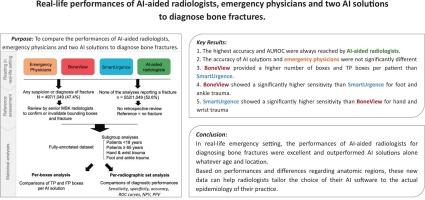Real-life performance of AI-aided radiologists, emergency physicians and two AI solutions for diagnosing bone fractures in appendicular skeletal trauma
IF 3.3
3区 医学
Q1 RADIOLOGY, NUCLEAR MEDICINE & MEDICAL IMAGING
引用次数: 0
Abstract
Objectives
To compare the performance of artificial intelligence (AI)-aided radiologists, emergency physicians and two AI solutions for diagnosing bone fractures.
Materials and Methods
Consecutive patients treated at two centres for appendicular skeletal traumatic injury between January and April 2021 who underwent X-ray imaging and whose initial conclusions were available and prospectively encoded by emergency physicians, were also prospectively analysed via two AI solutions (BoneView and SmartUrgence) available for the real-life interpretation of AI-aided radiologists. The ground truth was retrospectively assessed by 5 senior musculoskeletal radiologists who were aware of all the clinical, radiological and AI data. Numbers of suspected fractures, true positives and false positives per AI were compared. Diagnostic performance metrics (sensitivity, specificity, positive and negative predictive values and accuracy with 95% confidence intervals) for detecting fractures were estimated for each interpretation (emergency physician, BoneView, SmartUrgence, AI-aided radiologist).
Results
969 patients with 1049 radiography sets were included, 287 of whom had fractures (27.4 %). The average number of any fracture and true positive fractures were greater with BoneView than with SmartUrgence (P = 0.0469 and P = 0.0022, respectively). The real-life sensitivity, specificity and accuracy for detecting fracture in the entire cohort were 93 %, 99 % and 97.6 % for AI-aided radiologists; 80.8 %, 97.6 % and 93 % for emergency physicians; 89.5 %, 93.8 % and 92.7 % for BoneView; and 85.7 %, 94.6 % and 92.2 % for SmartUrgence.
Conclusion
In a real-life emergency setting, the performance of AI-aided radiologists in diagnosing bone fractures was excellent, and these radiologists outperformed AI solutions alone regardless of age and location.

人工智能辅助放射科医生、急诊医生和两种人工智能解决方案诊断阑尾骨骼创伤骨折的真实表现。
目的:比较人工智能(AI)辅助放射科医生、急诊医生和两种人工智能解决方案在骨折诊断中的表现。材料和方法:2021年1月至4月期间在两个中心连续治疗的阑尾骨骼创伤性损伤患者接受了x射线成像,急诊医生可获得初步结论并对其进行前瞻性编码,也可通过两种人工智能解决方案(BoneView和smarturence)进行前瞻性分析,用于人工智能辅助放射科医生的现实解释。5名了解所有临床、放射学和人工智能数据的高级肌肉骨骼放射科医生对基本事实进行了回顾性评估。比较每个AI的疑似骨折数量、真阳性和假阳性。评估每种解释(急诊医生、BoneView、smarturence、ai辅助放射科医生)检测骨折的诊断性能指标(敏感性、特异性、阳性和阴性预测值以及95%置信区间的准确性)。结果:纳入969例患者1049组x线片,其中骨折287例(27.4%)。BoneView的平均任意骨折数和真阳性骨折数均大于smarturence (P = 0.0469和P = 0.0022)。人工智能辅助放射科医师在整个队列中检测骨折的实际敏感性、特异性和准确性分别为93%、99%和97.6%;急诊医师占80.8%、97.6%和93%;BoneView分别为89.5%、93.8%和92.7%;smarturence分别占85.7%、94.6%和92.2%。结论:在现实急诊环境中,人工智能辅助放射科医生诊断骨折的表现非常出色,无论年龄和位置如何,这些放射科医生的表现都优于单独使用人工智能解决方案。
本文章由计算机程序翻译,如有差异,请以英文原文为准。
求助全文
约1分钟内获得全文
求助全文
来源期刊
CiteScore
6.70
自引率
3.00%
发文量
398
审稿时长
42 days
期刊介绍:
European Journal of Radiology is an international journal which aims to communicate to its readers, state-of-the-art information on imaging developments in the form of high quality original research articles and timely reviews on current developments in the field.
Its audience includes clinicians at all levels of training including radiology trainees, newly qualified imaging specialists and the experienced radiologist. Its aim is to inform efficient, appropriate and evidence-based imaging practice to the benefit of patients worldwide.

 求助内容:
求助内容: 应助结果提醒方式:
应助结果提醒方式:


